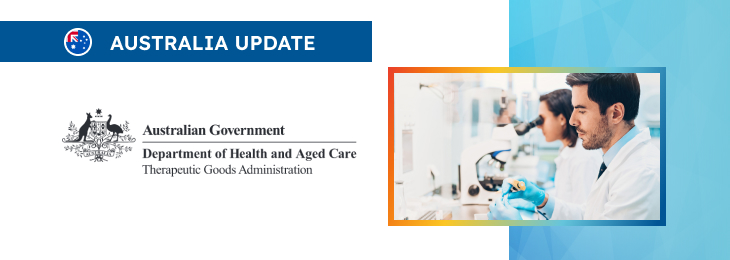The article outlines the key points associated with the regulatory requirements for in vitro diagnostic medical devices intended to be marketed and used in Australia.

Table of content
The Therapeutic Goods Administration (TGA), an Australian regulating authority in the sphere of healthcare products, has published a guidance document dedicated to the regulatory requirements for in vitro diagnostic medical devices. The document provides an overview of the existing legal framework, as well as additional clarifications and recommendations to be taken into consideration by the parties responsible for such devices (sponsors) in order to ensure compliance.
At the same time, provisions of the guidance are non-binding in their legal nature, nor are they intended to introduce new rules or impose new obligations. The authority also reserves the right to make changes to the guidance and recommendations provided therein, should such changes be reasonably necessary to reflect corresponding amendments to the underlying legislation.
Overview of IVD Devices and Regulatory Processes
Under the general rule, in vitro diagnostic (IVD) devices are medical instruments used to perform tests on samples taken from the human body. These devices encompass reagents, calibrators, control materials, kits, specimen receptacles, software, instruments, apparatuses, equipment, or systems.
They are primarily intended to provide information on physiological or pathological states, congenital abnormalities, and to determine safety and compatibility with potential recipients or monitor therapeutic measures. The regulation and classification of IVDs ensure their safety, efficacy, and quality before being included in the Australian Register of Therapeutic Goods (ARTG).
The Therapeutic Goods Administration oversees the regulation of therapeutic goods in Australia, including IVDs. Sponsors must follow specific steps to include their products on the ARTG, which involves submitting applications electronically through the TGA’s eBusiness Services system.
New users must establish an e-business account to access these services, enabling them to manage their applications and compliance documentation effectively.

Classification and Nomenclature
The classification of IVDs is crucial for determining the appropriate regulatory pathway. The manufacturer must classify the IVD based on its intended purpose according to established classification rules.
Additionally, each IVD must be assigned a Global Medical Device Nomenclature (GMDN) code, which is a collection of internationally recognized terms that accurately describe and catalog medical devices. This responsibility falls on the manufacturer to ensure accurate classification and nomenclature.
Manufacturer’s Evidence and Conformity Assessment
As further explained by the TGA, for Class 2 and Class 3 IVDs, manufacturers must undergo conformity assessment by the TGA. This process verifies that the devices meet essential requirements for quality, safety, and performance.
Class 4 IVDs, including those manufactured overseas, must also undergo TGA’s conformity assessment. Sponsors are generally expected to obtain the manufacturer’s Declaration of Conformity before submitting an application to include a medical device on the ARTG.
The declaration should encompass details outlined in the Australian Regulatory Guidelines for Medical Devices (ARGMD).
Submission Process and Evidence Requirements
When submitting an application through eBusiness Services, sponsors must include only the Quality Management System (QMS) certificate as evidence. The TGA may request additional information, such as the Declaration of Conformity, during the assessment process.
All product GMDNs applicable to the evidence must be entered prior to finalizing the submission. Once the evidence is accepted, it will be linked to the medical device application, streamlining the approval process.
Inclusion in the ARTG and Ongoing Responsibilities
Sponsors can include IVDs of the “same kind” under a single medical device application if they share the same sponsor, manufacturer, GMDN, and risk classification. Class 4 IVDs must also have the same unique product identifier (UPI).
When lodging an application, sponsors must certify that the product is a medical device intended for a specific purpose, correctly classified, compliant with Australian essential principles for quality, safety, and performance, and adheres to advertising requirements. They must also confirm that the IVD does not contain prohibited substances and that all information in the application is complete and correct.
Technical File Review and Evaluation Fees
In addition to the above, it is important to mention that certain IVDs, such as those used for self-testing, point-of-care tests, and tests for notifiable sexually transmitted infections, require mandatory Technical File Review (TFR). Other applications may be selected for a non-mandatory TFR.
Sponsors are invoiced an evaluation fee for IVDs undergoing a mandatory TFR, while those selected for a non-mandatory TFR or an application audit do not attract this fee. Overall, the inclusion of IVDs in the ARTG involves a thorough and structured process to ensure their safety, quality, and efficacy.
Sponsors and manufacturers should follow the specific requirements and undergo conformity assessments, ensuring compliance with Australian regulations. Ongoing responsibilities set forth under the existing legal framework include maintaining the integrity and compliance of the product, responding to TGA requests within specified timeframes, and ensuring all necessary documentation is up-to-date and accurate.
Conclusion
In summary, the present guidance document prepared by the TGA provides a brief overview of the regulatory requirements IVDs are subject to in Australia. The document outlines the key points to be taken into consideration when planning and placing such products on the market in order to streamline and facilitate the process.
How Can RegDesk Help?
RegDesk is an AI-powered Regulatory Information Management System that provides medical device companies with regulatory intelligence for over 120 markets worldwide. It can help you prepare and publish global applications, manage standards, run change assessments, and obtain real-time alerts on regulatory changes through a centralized platform. Global expansion has never been this simple.

